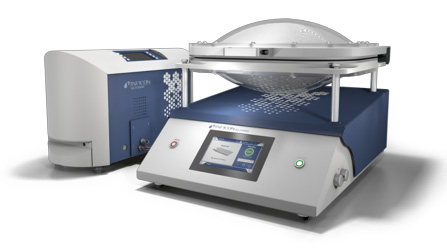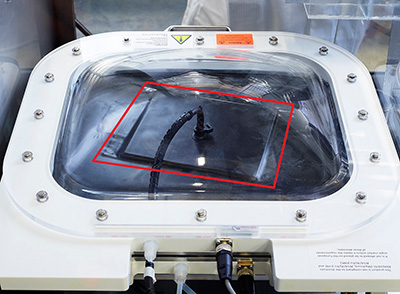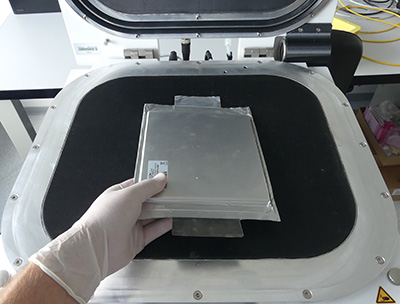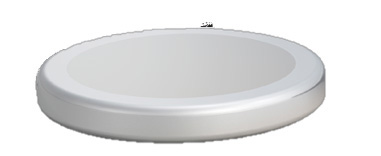NEW - ELT3000 Now also Available for Pouch Cell Testing

ELT3000 Leak Detector for Lithium-Ion Battery Cells with FTC3000 installed on top of the Gas Control Unit

The two membranes of the FTC3000 flexible chamber form a customized chamber around the pouch cell to be tested to avoid swelling of the pouch which may stress the seals.

Pouch cell being inserted into the FTC3000 flexible chamber.
INFICON recently announced a new device for integrity testing of lithium-ion battery cells, such as those used in mobile devices or in drive batteries for EV, HEV and FCV vehicles. The product portfolio has now been expanded by an FTC3000 flexible chamber for pouch cell testing.
The flexible chamber was originally developed for leak testing of food packages and has now been adopted to the needs of pouch cell battery testing. A pouch cell is placed between two membranes and when the chamber lid is closed a vacuum is applied in the small space between the two membrane layers. Pouch cells when exposed to vacuum without any support bear the risk of inflating and finally bursting. The two membranes of the flexible chamber form a customized chamber around the pouch cell (like in vacuum packaging), thus supporting the pouch cells mechanically and preventing any damage to the pouch cell due to leak testing. The patented design of the flexible chamber enables non-destructive testing of pouch cells under vacuum conditions. The testing envelope of the flexible chamber is 380 mm x 380 mm and allows the user to test either one larger pouch cell or several smaller pouch cells.
Direct leak testing by detection of electrolyte solvent
The new ELT3000 device consists of two components: a gas detection system for electrolyte solvents and a control unit for the gas flows. After the battery is placed in the FTC3000 flexible chamber, the test can be started at the push of a button. The control unit then generates a vacuum of a few mbar absolute in the chamber. Battery cells are usually filled with electrolyte at a pressure of 50 to 300 mbar. The pressure difference causes electrolyte to escape from the cell through any leaks and the solvent content evaporates in the vacuum of the test chamber. This makes it detectable for the mass spectrometer of the gas detection system. The ELT3000 can directly detect all common electrolyte solvents such as DMC, DEC or EMC. The cycle times for testing pouch cells in the FTC3000 flexible chamber is about 45 seconds.
Traceable results
The ELT3000 identifies leaks by directly detecting leaking electrolyte solvent. At the same time, it minimizes human error sources during testing and ensures traceable results. The device stores all test data for export and can be reliably calibrated using the INFICON E-Check test leaks, fulfilling the requirements of the ISO9000 standard. The detection system compares the result of each test with a previously defined trigger value and immediately indicates any leaks. It is also very easy to assign test results to the specific test object. Simply connect a barcode scanner to the standardized interface of the ELT3000, which can be used to record each cell individually. The system then links the exact test results with the respective part ID and a time stamp.

E-Check test leak for ELT3000
Product Availability
The flexible FTC3000 chamber comes as an accessory to the ELT3000 and will be available for order starting March 1, 2021.
Further information can be found in our brochure and on our website. For detailed questions, please contact your nearest sales representative.
